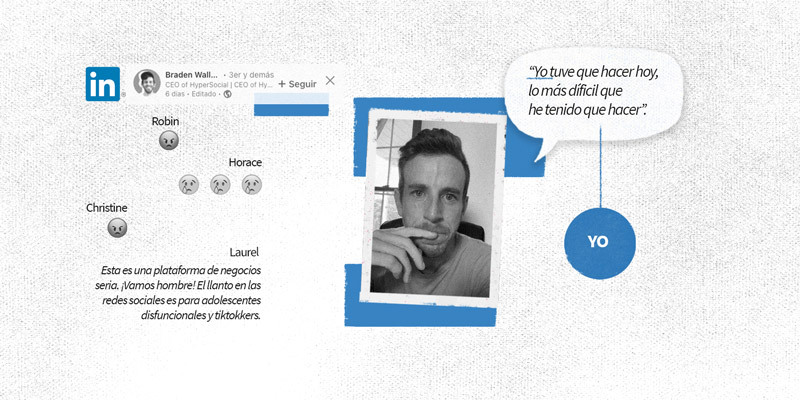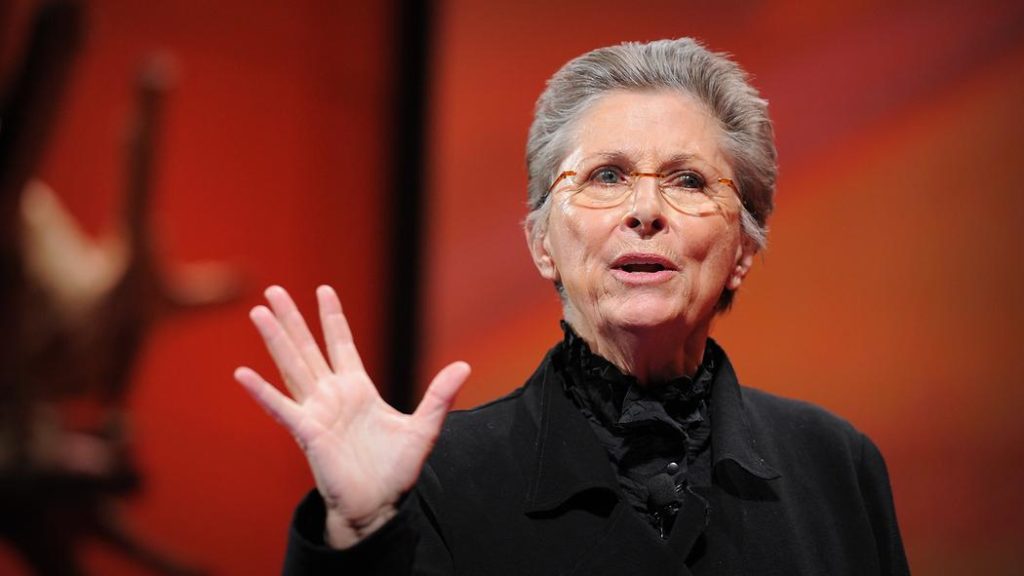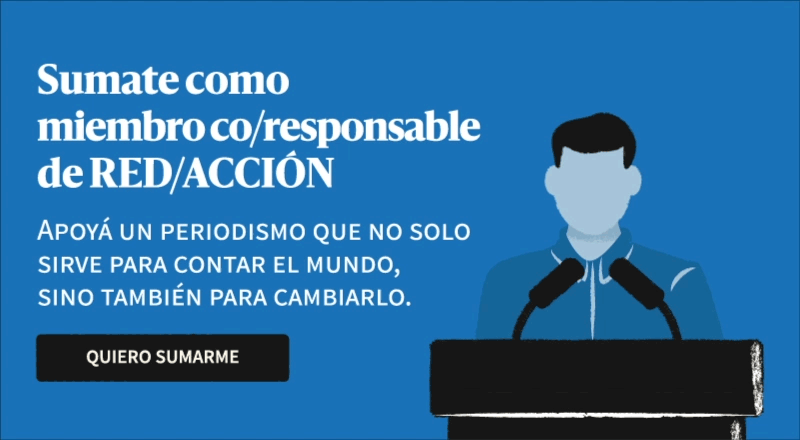A CEO posted a photo on LinkedIn of himself crying over having to lay off 17 employees. His followers rejected his attempt to inspire pity when the real victims were the fired employees. A case that leaves universal lessons that should not be ignored.
Share this newsletter or subscribe
1

Usurper. Braden Wallake is the CEO of HyperSocial, a company specializing in social media campaigns. A few months ago, he made some bad business decisions and his mistakes were soon felt in the company’s finances. He had no choice but to fire some of his employees: normal in these cases. The story took an unexpected turn when the good Braden had the idea of publishing in LinkedIn a photo of him crying, with an explanation of how much he had suffered from the dismissals. Capital error.
The post generated almost ten thousand comments. The majority, critics: Wallake was pointed out by his followers as narcissistic and self-referential. The crowd’s claim, moreover, hit the nail on the head: in these sad stories, it’s not the tears of a CEO that deserve compassion, but those of those who lost their jobs. For the networks, the attempt to take the place of the victim sounded like usurpation. And the same thing happened with the media: Washington Post, Fast Company Y Guardian, among others, lapidary articles were dedicated to him. A nightmare.
Wallake’s misstep leaves some lessons that transcend HyperSocial. The communication of painful situations involving organizations admits a basic questionnaire that provides clarity and method:
- What do I want to communicate? Many messages fail this first question successfully. If Wallake had done it, the answer would have been: “that CEOs also suffer from difficult decisions.” And if he had spoken it out loud, he would probably have single-handedly noticed its irrelevance, which is confirmed or refuted by the second question:
- And who cares? What stakeholders may have a genuine interest in the message: shareholders, employees, customers, suppliers, government? Probably none of them, but that ends up being answered with a third question:
- Why would they be interested? In the case of HyperSocialHow relevant are Wallake’s feelings when he fires employees. Family and friends may celebrate her sensitivity. Your therapist may value your ability to empathize. The rest of the public may suffer the bewilderment. The following question works as an acid test:
- What are the possible interpretations? The most common prejudice says that CEOs do not have financial problems or fear losing their jobs, two of the most universal concerns. That makes it difficult to empathize with them. In that context, if the message does not inspire sympathy, it may generate other feelings. Which? This leads to the fifth question, which works as a final test:
- How are roles assigned in the story? There are anniversaries, investment announcements, apologies and other stories in which organizations cannot resist the temptation to appropriate the leading role of the hero: what happened to Wallake. The golden rule says the opposite: the hero is always the victim, the employee, the customer, the underdog. The other. Never the mighty. Never.
Braden’s stumble transcends his case: it serves to remind politicians, religious leaders, company presidents and other relevant figures that with their messages they can inspire respect, admiration, fear, enthusiasm… even love. But almost never compassion. Sir, madam, don’t even try: avoid irritating your audiences.
two

Three questions to Joan Halifax. She is an American Zen Buddhist teacher, anthropologist, environmentalist, civil rights activist, caregiver, and author of several books on Buddhism and spirituality.
- doWhy is compassion so important to you??
Compassion has many faces. The Dalai Lama used to say: “Love and compassion are necessities, not luxuries. Without them, humanity can not survive”. And I would suggest that it is not only humanity that could not survive, but all species on the planet, from big cats to plankton. Two weeks ago I had the privilege of being in India. I was able to teach in a hospice outside of Bangalore. One morning I stood before 31 men and women who were dying. I saw a woman who was breathing with great difficulty, already in her final phase, and her son, who showed pain and confusion on his face, and I remembered a line from Mahabharata, that great Indian epic: What is the most amazing thing of the world, Yudhishthira? And the answer: that there may be people dying around us, and we don’t realize that this could be happening to us. And I saw a young woman whose face showed real and natural compassion, as she bathed an old man. Those hands once touched me, and that’s why I know what compassion is.
- doWhat is compassion made of??
There are several facets of compassion. The first thing is the ability to see clearly the nature of suffering, it is the ability to stand strong and recognize that one is not separate from suffering. But that is not enough, because compassion activates a part of the brain that makes us aspire to transform suffering, and we are truly blessed when we engage in activities that transform suffering. But there is another really essential component, which is that we cannot commit ourselves to a certain result. I have worked with people who are dying for over 40 years, and I realize that any commitment to a certain outcome would destroy my ability to be fully present where I am. Compassion is inherent in human nature, it is in all of us, but the conditions for it to be activated must be generated. I was activated from my childhood by a disease I had.
- doWhat factors conspire against compassion?
It is fascinating that compassion has its enemies: sadness, moral errors, fear. We live in a society paralyzed by fear, and that paralysis also generates the impossibility of having compassion. The word “terror” is global, just like the feeling. We have to deal with that, with that archetype that works in the whole world. We know from neuroscience that compassion has extraordinary qualities. For example: whoever cultivates compassion, when he is in the presence of suffering, is capable of suffering more than others, but returns to normal much sooner. That is called resilience. It is known that compassion generates a neuronal integration that involves all parts of the brain, and even favors our immunity. If compassion is so good for us, we might wonder why we don’t train our children to feel compassion.
The three questions to Joan Halifax were taken from the presentation “Compassion and the true meaning of empathy”, given in the context of TEDx. To access the full talk you can click here.

3
Macron. In March of this year, when attempts were still being made to dissuade Putin from his decisions regarding the invasion of Ukraine, the French president had some talks with his Russian counterpart that were reported in the international press. the french government shared on the networks photos in which Emmanuel Macron seemed to break down with worry and pain caused by the impending war in Ukraine. The memes did not wait, making fun of the drama of the French president. Another case in which the theatricality of the gestures of a powerful person compromises his credibility. Watch out.
4
Academy. The importance of compassion is widely recognized and is receiving increasing research attention. This article proposes a definition of compassion and lists five main elements: recognizing suffering, understanding the universality of human suffering, feeling for the person who suffers, tolerating uncomfortable feelings, and being motivated to act/act to relieve suffering. A contribution from the academy to analyze this phenomenon as old as humanity, which has not yet been analyzed in its communication phase.
5
Job opportunities
Bacardi keep your search open Digital Marketing & Brand Communications, Head Latin America & Caribbean (LAC).
NTT Data Europe & Latam continue your search for Communication and Marketing Leader.
Here we come this week. All your ideas, proposals or queries are welcome. can you write to me [email protected]
Until next Wednesday!
Juan
You can read all the editions of Comms in this link.
With support from
Media Partner

* The content of Comms does not necessarily represent the institutional position of the DirComs Circle. The Circle of Communication Directors (DirComs) is a civil association that seeks to promote the exchange of knowledge and experiences among the heads of corporate communication, institutional relations, public and government affairs of the main companies in the country. *

